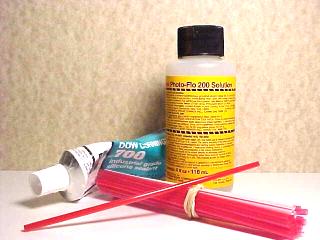Applying Silicone to flies is a sticky operation which
many of us would I am sure just as soon avoid, if possible.
However, some patterns use silicone as an integral part of
the fly to hold materials, such as eyes, in place.
In addition the fish seem to like the tactile sensation
they get from silicone as well. They actually hold onto
a fly tied with silicone a bit longer than one tied without
it. There must be a correlation between the soft, springy
quality of the silicone, and the resistive quality of the
food which they imitate.
In any case, silicone is here to stay and we might as well
learn how to work with it properly. The nature of the beast
is such that you are as likely to get as much stuck to your
fingers as you do to the fly. But, take heart, there is a
way to get a nice smooth body without the usual lumps
associated with silicone, and keep your fingers at least
somewhat clean.

A trip to your local photographic darkroom supply store
to pick up a small bottle of Kodak "Photo Flo" is your
first step to un-gooping yourself. (if there is no store
near you, mail order is your next best bet.)
Now, when applying the silicone, first use a "swizzle stick"
to spread the material roughly about the fly in the areas you
wish covered.
Next, wet your fingers with the Kodak "Photo Flo" and smooth
and shape the silicone as the pattern requires.
You will notice that the silicone no longer sticks to your
fingers. It also is quite smooth on the fly.
Next time you get into the silicone, wet your fingers first
with "Photo Flo."
If you have any tips or techniques, send them along, most of this
material has been stolen from somebody, might as well steal your ideas
too!~ George E. Emanuel
(Chat Room Host Muddler)
|

